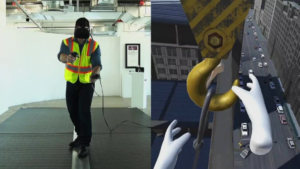Safety
 Statistically, the construction industry is one of the most dangerous industries to work in, with many studies finding that this industry experiences the most workplace deaths out of all major industries. Additionally, construction site workers are among the most likely to experience nonfatal workplace injuries. This is despite the efforts of the Occupational Safety and Health Administration (OSHA) and onsite safety coordinators. Technology such as augmented and virtual reality, can be used to test scenarios, potentially preventing dangerous situations and disasters. Improvements of harness designs, hardhats, and other safety gear are also being made and implemented to better protect individuals from hazards and prevent accidents.
Statistically, the construction industry is one of the most dangerous industries to work in, with many studies finding that this industry experiences the most workplace deaths out of all major industries. Additionally, construction site workers are among the most likely to experience nonfatal workplace injuries. This is despite the efforts of the Occupational Safety and Health Administration (OSHA) and onsite safety coordinators. Technology such as augmented and virtual reality, can be used to test scenarios, potentially preventing dangerous situations and disasters. Improvements of harness designs, hardhats, and other safety gear are also being made and implemented to better protect individuals from hazards and prevent accidents.
Although controversial, some companies placing robots or unmanned aerial vehicles in dangerous jobs instead of human workers. This might appear on the surface like they are replacing workers with robots, but for many companies, this simply shifts the workforce. Instead of people being in a potentially hazardous environment, there are people controlling, programing, monitoring, repairing, building, testing, and designing robots or machinery to do the tasks.
Speed
Emerging technology is also influencing the speed at which tasks both on and off the construction site are being completed. This can directly affect the public, as the faster tasks get done, the faster people get their home, doctor’s offices, and restaurants. Technology such as drones can complete tasks such as mapping, surveying, image capturing, environmental impact assessments and progress monitoring faster and using less materials than humans. Additionally, drones and other machinery may be able to function in conditions and situations not suitable for people such as at night, in the extreme heat or cold, in the rain, or in the snow. One of the main benefits associated with 3D printing buildings and structures is that the machines can run constantly through the night with the right setup, saving time, money, and resources. As mentioned previously, in many cases, implementing robots and machinery does not replace jobs, but simply shifts the workforce.
Virtual and augmented reality has the potential to expedite training for people seeking new certifications or for new employees. This could cut down the time between hiring and being onsite. This would not only positively impact employers but employees and their families as well.
Sustainability
 Sustainability is an important part of the construction industry as it has one of the largest carbon footprints out of all the major industries. The resurgence of technology such as green concrete and self-healing concrete and the increasing popularity of 3D printing concrete technology has the potential to make a great impact on the industries carbon emissions if implemented at a large scale. All three of these technologies can be more environmentally friendly alternatives to traditional concrete. They have the potential to produce less waste and emit less carbon. Certain types of green concrete also have the added benefit of using the waste materials of other industries to replace some of the cement in concrete. This is especially advantageous as cement production emits the most carbon out of all the sets of the concrete manufacturing, transpiration, and installation project.
Sustainability is an important part of the construction industry as it has one of the largest carbon footprints out of all the major industries. The resurgence of technology such as green concrete and self-healing concrete and the increasing popularity of 3D printing concrete technology has the potential to make a great impact on the industries carbon emissions if implemented at a large scale. All three of these technologies can be more environmentally friendly alternatives to traditional concrete. They have the potential to produce less waste and emit less carbon. Certain types of green concrete also have the added benefit of using the waste materials of other industries to replace some of the cement in concrete. This is especially advantageous as cement production emits the most carbon out of all the sets of the concrete manufacturing, transpiration, and installation project.
Efficiency
Efficiency in the construction industry has made leaps and strides in recent years. From the resurgence of green concrete and self-healing concrete to the potentially waste reducing 3D concrete printing technology, new and improved technology is making the construction industry more efficient than ever.
It is important to recognize that efficiency isn’t just about how fast a project is completed. Time and resource usage as well as quality all factor into efficiency as well. Therefore, any new technology that positively impacts the speed and resource management of a project can be incredibly beneficial.
Training
New technology is constantly being utilized to make training for both on and off-site jobs safer, faster, and more efficient. For example, recently some companies have begun utilizing virtual and augmented reality to help train employees. This technology can simulate situations and environments that employees may encounter, allowing them to experience and react to conditions without endangering themselves or those around them in the learning process. Just like a video game, participants can learn and adapt to new and dynamic scenarios that would otherwise be difficult, dangerous, or time consuming to set up and run through. It also has the potential to make job training more accessible for those who learn best through hands on experience rather than through lectures, PowerPoints, textbooks, and tests. New software is constantly being developed to make education and training easier and safer for employers and employees.
Labor
 Like many other industries, the construction industry is still suffering from a skilled labor shortage. By shifting the area in need of skilled labor using new technology, companies may be able to lessen the labor shortage plaguing them. Instead of people doing hard labor, or potentially dangerous jobs, they would need to hire employees for more tech related positions such as people controlling, programing, monitoring, repairing, building, testing, and designing robots or machinery. This is unlikely to replace the people currently working as subcontractors and construction workers, but instead fill the positions they have been unable to hire for. This can directly impact the speed and efficiency at which projects get completed.
Like many other industries, the construction industry is still suffering from a skilled labor shortage. By shifting the area in need of skilled labor using new technology, companies may be able to lessen the labor shortage plaguing them. Instead of people doing hard labor, or potentially dangerous jobs, they would need to hire employees for more tech related positions such as people controlling, programing, monitoring, repairing, building, testing, and designing robots or machinery. This is unlikely to replace the people currently working as subcontractors and construction workers, but instead fill the positions they have been unable to hire for. This can directly impact the speed and efficiency at which projects get completed.
Communication
Reliable, efficient, accurate, and frequent communication is essential for a successful construction project. This requires reliable, efficient, and accurate technology. With devices like drones that can record and transmit real-time aerial images updating all parties involved in a project has never been easier. With the invention of longer-range Bluetooth devices, more affordable smart phones, and more powerful radios, jobsite communication has also seen an improvement. And, although it is not a technology, in recent years many companies have begun hiring communications coordinators who utilize new and improved technologies to create easier and more efficient communication between client and contractor, contractor and subcontractors, architects and designer, and so much more.






